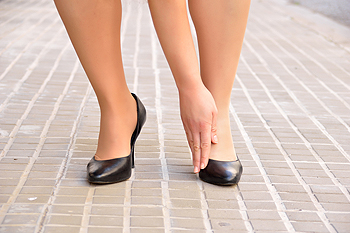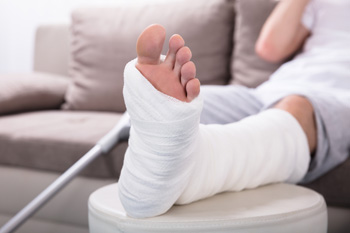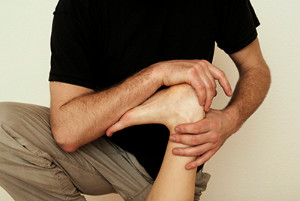
Wilmington (937) 382-2347
Fax
(513) 932-1606

Wilmington (937) 382-2347
Fax
(513) 932-1606
 Many women enjoy wearing high heels despite having the knowledge that the feet may be negatively affected. Research has shown the Achilles tendon may become shorter and stiffness may occur as a possible result of frequently wearing high heels. Additionally, balance and posture may become affected as the center of gravity changes, and the muscles surrounding the ankle may be compromised. There may be solutions that can be implemented to protect the feet from wearing high heels, and these may include choosing to wear shoes that have a lower heel, reducing the amount of days and time spent wearing high heels, or wearing soft insoles, which may provide adequate cushioning for the feet. If you would like additional information about the effects high heels can have on your feet, please speak with a podiatrist who will be able to suggest proper foot strengthening exercises.
Many women enjoy wearing high heels despite having the knowledge that the feet may be negatively affected. Research has shown the Achilles tendon may become shorter and stiffness may occur as a possible result of frequently wearing high heels. Additionally, balance and posture may become affected as the center of gravity changes, and the muscles surrounding the ankle may be compromised. There may be solutions that can be implemented to protect the feet from wearing high heels, and these may include choosing to wear shoes that have a lower heel, reducing the amount of days and time spent wearing high heels, or wearing soft insoles, which may provide adequate cushioning for the feet. If you would like additional information about the effects high heels can have on your feet, please speak with a podiatrist who will be able to suggest proper foot strengthening exercises.
High heels have a history of causing foot and ankle problems. If you have any concerns about your feet or ankles, contact Dr. Gerald Perelman from Ohio. Our doctor can provide the care you need to keep you pain-free and on your feet.
Effects of High Heels on the Feet
High heels are popular shoes among women because of their many styles and societal appeal. Despite this, high heels can still cause many health problems if worn too frequently.
Which Parts of My Body Will Be Affected by High Heels?
What Kinds of Foot Problems Can Develop from Wearing High Heels?
How Can I Still Wear High Heels and Maintain Foot Health?
If you want to wear high heeled shoes, make sure that you are not wearing them every day, as this will help prevent long term physical problems. Try wearing thicker heels as opposed to stilettos to distribute weight more evenly across the feet. Always make sure you are wearing the proper shoes for the right occasion, such as sneakers for exercising. If you walk to work, try carrying your heels with you and changing into them once you arrive at work. Adding inserts to your heels can help cushion your feet and absorb shock. Full foot inserts or metatarsal pads are available.
If you have any questions please feel free to contact our office located in Wilmington, OH . We offer the newest diagnostic and treatment technologies for all your foot and ankle needs.
 Research has shown that one out of ten broken bones happens in the foot. If tripping, falling, or dropping a heavy object on your foot occurs, you may experience a painful condition known as a broken foot. You will immediately notice symptoms that may include severe pain and swelling, possibly hindering the ability to walk, and bruising or tenderness. Additionally, the toes may be deformed if the bones appear to be dislocated. If you have fallen and you think your foot may be fractured, a proper diagnosis must be performed that will confirm the broken foot. This is typically accomplished by having an X-ray taken, followed by a discussion of proper treatment methods. These may include keeping the foot stable by wearing a supportive boot. Other options may include the use of a splint or cast, and crutches would generally accompany this. If you feel you have broken your foot, it is strongly advised to speak to a podiatrist, so the correct treatment can be chosen.
Research has shown that one out of ten broken bones happens in the foot. If tripping, falling, or dropping a heavy object on your foot occurs, you may experience a painful condition known as a broken foot. You will immediately notice symptoms that may include severe pain and swelling, possibly hindering the ability to walk, and bruising or tenderness. Additionally, the toes may be deformed if the bones appear to be dislocated. If you have fallen and you think your foot may be fractured, a proper diagnosis must be performed that will confirm the broken foot. This is typically accomplished by having an X-ray taken, followed by a discussion of proper treatment methods. These may include keeping the foot stable by wearing a supportive boot. Other options may include the use of a splint or cast, and crutches would generally accompany this. If you feel you have broken your foot, it is strongly advised to speak to a podiatrist, so the correct treatment can be chosen.
A broken foot requires immediate medical attention and treatment. If you need your feet checked, contact Dr. Gerald Perelman from Ohio. Our doctor can provide the care you need to keep you pain-free and on your feet.
Broken Foot Causes, Symptoms, and Treatment
A broken foot is caused by one of the bones in the foot typically breaking when bended, crushed, or stretched beyond its natural capabilities. Usually the location of the fracture indicates how the break occurred, whether it was through an object, fall, or any other type of injury.
Common Symptoms of Broken Feet:
Those that suspect they have a broken foot shoot seek urgent medical attention where a medical professional could diagnose the severity.
Treatment for broken bones varies depending on the cause, severity and location. Some will require the use of splints, casts or crutches while others could even involve surgery to repair the broken bones. Personal care includes the use of ice and keeping the foot stabilized and elevated.
If you have any questions please feel free to contact our office located in Wilmington, OH . We offer the newest diagnostic and treatment technologies for all your foot and ankle needs.
 Research has shown the importance of stretching the toes and feet as frequently as possible. The many benefits of performing stretching techniques for the feet may include an improved range of motion, which may aid in keeping the feet and ankles strong, added flexibility that may contribute to providing additional support, in addition to possibly reducing any mild foot pain that may exist. There are a few simple and effective toe and foot stretches that can be performed. These may include raising your heels up and down while sitting in a chair, followed by pointing and flexing the toes. Additionally, stretches that are geared toward strengthening the top of the feet may include spreading the toes as far apart as possible while sitting down, holding for five seconds, followed by repeating this process up to ten times. If you would like to learn more about additional stretching movements that can benefit the feet and toes, it’s suggested to speak with a podiatrist for proper techniques.
Research has shown the importance of stretching the toes and feet as frequently as possible. The many benefits of performing stretching techniques for the feet may include an improved range of motion, which may aid in keeping the feet and ankles strong, added flexibility that may contribute to providing additional support, in addition to possibly reducing any mild foot pain that may exist. There are a few simple and effective toe and foot stretches that can be performed. These may include raising your heels up and down while sitting in a chair, followed by pointing and flexing the toes. Additionally, stretches that are geared toward strengthening the top of the feet may include spreading the toes as far apart as possible while sitting down, holding for five seconds, followed by repeating this process up to ten times. If you would like to learn more about additional stretching movements that can benefit the feet and toes, it’s suggested to speak with a podiatrist for proper techniques.
Stretching the feet is a great way to prevent injuries. If you have any concerns with your feet consult with Dr. Gerald Perelman from Ohio. Our doctor will assess your condition and provide you with quality foot and ankle treatment.
Stretching the Feet
Stretching the muscles in the foot is an important part in any physical activity. Feet that are tight can lead to less flexibility and make you more prone to injury. One of the most common forms of foot pain, plantar fasciitis, can be stretched out to help ease the pain. Stretching can not only ease pain from plantar fasciitis but also prevent it as well. However, it is important to see a podiatrist first if stretching is right for you. Podiatrists can also recommend other ways to stretch your feet. Once you know whether stretching is right for you, here are some excellent stretches you can do.
It is best to go easy when first stretching your foot and work your way up. If your foot starts hurting, stop exercising and ice and rest the foot. It is advised to then see a podiatrist for help.
If you have any questions, please feel free to contact our office located in Wilmington, OH . We offer the newest diagnostic and treatment technologies for all your foot care needs.
 Toenail fungus is a relatively common foot condition. If you are experiencing this type of foot ailment, you may notice symptoms including thick and yellowed toenails, debris collecting underneath brittle nails, and in severe cases, the toenails appearing deformed. This type of fungus is caused by yeast organisms that enter the nail bed and thrives in warm and dark environments. It is known to be extremely contagious, and appropriate footwear is suggested to be worn in public pools, showers, and surrounding areas. Research has shown that people who have compromised immune systems may be more susceptible in developing toenail fungus, in addition to those who have poor foot hygiene. Also, wearing closed shoes for extended periods of time may contribute to the onset of this unsightly foot condition. If you feel you have toenail fungus, it’s suggested to speak with a podiatrist who can properly begin correct treatment techniques.
Toenail fungus is a relatively common foot condition. If you are experiencing this type of foot ailment, you may notice symptoms including thick and yellowed toenails, debris collecting underneath brittle nails, and in severe cases, the toenails appearing deformed. This type of fungus is caused by yeast organisms that enter the nail bed and thrives in warm and dark environments. It is known to be extremely contagious, and appropriate footwear is suggested to be worn in public pools, showers, and surrounding areas. Research has shown that people who have compromised immune systems may be more susceptible in developing toenail fungus, in addition to those who have poor foot hygiene. Also, wearing closed shoes for extended periods of time may contribute to the onset of this unsightly foot condition. If you feel you have toenail fungus, it’s suggested to speak with a podiatrist who can properly begin correct treatment techniques.
For more information about treatment, contact Dr. Gerald Perelman of Ohio. Our doctor can provide the care you need to keep you pain-free and on your feet.
Toenail Fungus Treatment
Toenail fungus is a condition that affects many people and can be especially hard to get rid of. Fortunately, there are several methods to go about treating and avoiding it.
Antifungals & Deterrence
Oral antifungal medicine has been shown to be effective in many cases. It is important to consult with a podiatrist to determine the proper regiment for you, or potentially explore other options.
Applying foot powder on the feet and shoes helps keep the feet free of moisture and sweat.
Sandals or open toed shoes – Wearing these will allow air movement and help keep feet dry. They also expose your feet to light, which fungus cannot tolerate. Socks with moisture wicking material also help as well.
If you have any questions please feel free to contact our office located in Wilmington, OH . We offer the newest diagnostic tools and technology to treat your foot and ankle needs.